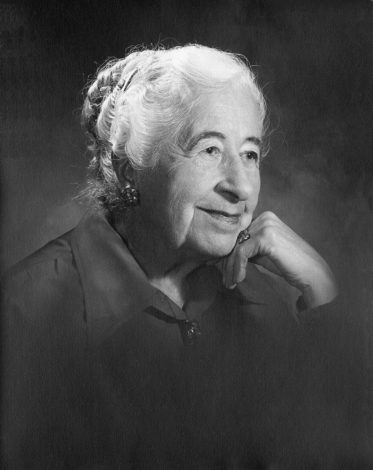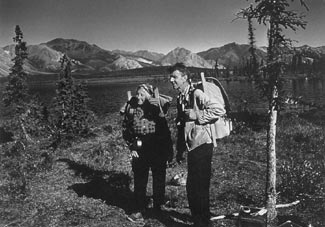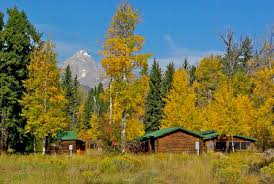Wife. Mother. Naturalist. Author. Adventurer. Conservationist.
Mardy Murie has been called the “Grandmother of the Conservation Movement.” Along with her husband, Olaus, she played a key role in preserving forever some of the country’s last wild places.
Who is Mardy Murie?
Margaret Elizabeth Thomas was born on August 18, 1902, in Seattle, Washington, to parents who divorced when she was young. Her mother remarried, and she spent much of her childhood in Fairbanks, Alaska, where her stepfather served as Assistant U.S. Attorney. She left Alaska to attend college in the lower 48, but met the love of her life on a trip home one summer. A neighbor introduced her to a young scientist for the U.S. Biological Survey studying caribou in Alaska.
She married Olaus Murie on August 1924 at a 3 a.m. sunrise wedding ceremony in a log chapel on the banks of the Yukon River. They left on their honeymoon the next day—a 6-month, 500-mile boat and dogsled caribou research trip through northern Alaska. Mardy quickly became a naturalist herself, and thereafter accompanied Olaus on his research trips, later bringing their three children along too.
The Muries moved to Jackson Hole, Wyoming, in 1927 when Olaus was sent to study the dwindling elk herd. Olaus resigned from the Biological Survey in 1945 and became President of the Wilderness Society and Mardy served as Secretary. Their ranch soon became the unofficial headquarters of the Society, hosting board meetings, debates and discussions from the 1940s to the 1960s. Some consider their home the birthplace of the modern conservation movement.
Olaus died in 1963, but Mardy continued the work they began together for four more decades. She wrote letters, attended hearings, testified before Congress and gave speeches on wilderness. She worked tirelessly until the end. She died at home on October 19, 2003, at the age of 101.
Accomplishments

Olaus and Mardy were instrumental in the creation of Jackson Hole National Monument, and later Grand Teton National Park in Wyoming.
They personally led the movement to create the Arctic National Wildlife Refuge in Alaska (1960), even leading the expedition of biologists in 1956 to gather data in support of the idea.
The Muries played key roles in the passage of the Wilderness Act of 1964, which, to date, has protected 110 million acres of land in pristine condition. The idea behind the act was birthed at the Murie Ranch.
In 1975, Mardy was chosen to be part of a task force that traveled to Alaska to identify land to be included in the Alaska

National Interest Lands Conservation Act. Her testimony was key to the passage of the act in 1980, which protected over 100 million acres of land in Alaska as national parks, national monuments, wild and scenic rivers, recreation areas, national wildlife refuges, and conservation areas. It is still considered the greatest preservation legislation in U.S. history.
Mardy authored Two in the Far North (1962), Wapiti Wilderness (1966) and Island Between.
Mardy received the Audubon Medal (1980), the John Muir Award (1983), the Presidential Medal of Freedom (1998), and several honorary doctorates for her work.
Love of Nature
Mardy once said, “I think most of my philosophy could be expressed in a very few words that were found on an old tombstone in Cumberland, England. Olaus put them on a plaque hanging over our mantlepiece: 'The wonder of the world, the beauty and the power, the shapes of things, their colours, lights and shades—these I saw. Look ye also while life lasts.'"
The beauty of Alaska and the mountains of Wyoming, her husband’s contagious passion for wildlife, the years spent living in a tent outdoors with her family in wilderness areas—these drew Mardy into a life of conservation. For her, it began with love—of a place, of a man, of wilderness.
QUICK FACTS
Mardy was the first female graduate of the University of Alaska in 1924.
The Muries were the inspiration for John Denver’s song “A Song for All Lovers”
Mardy’s half-sister, Louise, married Olaus’ half-brother, Adolph, who was also a biologist. Olaus and Adolph pioneered the ecological approach to wildlife management on public lands still in use today–one that validates the role of predators in the ecosystem.
The Muries' ranch is now part of Grand Teton National Park, Wyoming, and home to the Murie Center, an organization whose mission is to inspire rising conservation leaders.
CONNECTING TO KIDS
Want to share Mardy’s legacy with your kids? Here are several ways to do that.
Read
Mardy Murie Did! Grandmother of Conservation by Jequita Potts McDaniel.
Read
Friends of the Earth: A History of American Environmentalism with 21 Activities for Kids by Pat McCarthy. There’s a fascinating chapter on Mardy Murie among other key conservationsists.
Learn more about the areas preserved by the Wilderness Act by completing the
NPS Wilderness Explorer: Junior Ranger Activities and Adventures for 8 and Up booklet.
Visit the
Arctic National Wildlife Refuge website to see photos of a place Mardy loved and fought to preserve

 Olaus and Mardy were instrumental in the creation of Jackson Hole National Monument, and later Grand Teton National Park in Wyoming.
They personally led the movement to create the Arctic National Wildlife Refuge in Alaska (1960), even leading the expedition of biologists in 1956 to gather data in support of the idea.
The Muries played key roles in the passage of the Wilderness Act of 1964, which, to date, has protected 110 million acres of land in pristine condition. The idea behind the act was birthed at the Murie Ranch.
In 1975, Mardy was chosen to be part of a task force that traveled to Alaska to identify land to be included in the Alaska
Olaus and Mardy were instrumental in the creation of Jackson Hole National Monument, and later Grand Teton National Park in Wyoming.
They personally led the movement to create the Arctic National Wildlife Refuge in Alaska (1960), even leading the expedition of biologists in 1956 to gather data in support of the idea.
The Muries played key roles in the passage of the Wilderness Act of 1964, which, to date, has protected 110 million acres of land in pristine condition. The idea behind the act was birthed at the Murie Ranch.
In 1975, Mardy was chosen to be part of a task force that traveled to Alaska to identify land to be included in the Alaska  National Interest Lands Conservation Act. Her testimony was key to the passage of the act in 1980, which protected over 100 million acres of land in Alaska as national parks, national monuments, wild and scenic rivers, recreation areas, national wildlife refuges, and conservation areas. It is still considered the greatest preservation legislation in U.S. history.
Mardy authored Two in the Far North (1962), Wapiti Wilderness (1966) and Island Between.
Mardy received the Audubon Medal (1980), the John Muir Award (1983), the Presidential Medal of Freedom (1998), and several honorary doctorates for her work.
National Interest Lands Conservation Act. Her testimony was key to the passage of the act in 1980, which protected over 100 million acres of land in Alaska as national parks, national monuments, wild and scenic rivers, recreation areas, national wildlife refuges, and conservation areas. It is still considered the greatest preservation legislation in U.S. history.
Mardy authored Two in the Far North (1962), Wapiti Wilderness (1966) and Island Between.
Mardy received the Audubon Medal (1980), the John Muir Award (1983), the Presidential Medal of Freedom (1998), and several honorary doctorates for her work.




Comments